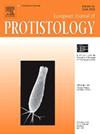非洲白蚁和白蚁肠道中无丝纤维纤毛虫的系统发育、形态和超微结构。
IF 1.6
2区 生物学
Q4 MICROBIOLOGY
引用次数: 0
摘要
据报道,无孔白蚁(oligohymehorea, peritricia, Sessilida)在某些“高等白蚁”(白蚁科)的肠道中定居,但只有一种白蚁,即来自Jugositermes tuberculatus (Apicotermitinae亚科)的非洲白蚁(Termitophrya africana),已经根据图纸进行了描述。在其他尖蚁科中也观察到类似的纤毛,但未明确。我们基于SSU rRNA基因的调查在广泛的白蚁科中发现了几种不同的尖白蚁科(Astalotermes, Jugositermes和Phoxotermes)的不同种型,尽管只是来自喀麦隆收集的样本,而不是所有这些属的物种。它们形成了一种单系类群,与凤梨花Orborhabdostyla bromelicola是最近的亲戚。结核菌无丝纤毛虫的光镜、扫描电镜和透射电镜显示了两种形态类型,通过对毛细采摘单细胞的序列分析,将两种形态类型划分为相应的种型。其中一种形态是高度收缩的,向后端不断变宽,与非洲白蚁的描述相符。细胞由具有短纤毛的后镜附着,并常被杆状外生菌覆盖。另一种形态具有较粗壮的桶状体和短而界限清晰的前端,并且总是不含外生菌。我们将其命名为Doliophrys denislynni gen. nov., sp. nov.。本文章由计算机程序翻译,如有差异,请以英文原文为准。

Phylogeny, morphology, and ultrastructure of sessilid peritrich ciliates in termite guts, Termitophrya africana and Doliophrys denislynni gen. nov., sp. nov.
Sessilids (Oligohymenophorea, Peritrichia, Sessilida) reportedly colonize the gut of certain “higher termites” (family Termitidae), but only a single species, Termitophrya africana from Jugositermes tuberculatus (subfamily Apicotermitinae), has been described based on a drawing. Similar ciliates were observed in other Apicotermitinae but remained unspecified. Our SSU rRNA gene-based survey of peritrich ciliates in a broad range of Termitidae recovered distinct phylotypes from several Apicotermitinae (Astalotermes, Jugositermes, and Phoxotermes), albeit only from samples collected in Cameroon and not from all species of these genera. They form a monophyletic group in the family Epistylididae (Sessilida), with Orborhabdostyla bromelicola as the closest relative. Light, scanning, and transmission electron microscopy of the sessilid ciliates in J. tuberculatus revealed two morphotypes, which were assigned to their corresponding phylotypes by sequence analysis of capillary-picked single cells. One morphotype, which is highly contractile and broadens continuously towards the posterior end, matches the description of Termitophrya africana. The cells are attached by a posterior scopula with short cilia and are often covered with rod-shaped ectobionts. The other morphotype has a stockier, barrel-shaped body and a short, clearly demarcated anterior end and is always free of ectobionts. We designate it as Doliophrys denislynni gen. nov., sp. nov.
求助全文
通过发布文献求助,成功后即可免费获取论文全文。
去求助
来源期刊

European journal of protistology
生物-微生物学
CiteScore
4.60
自引率
20.70%
发文量
55
审稿时长
14.6 weeks
期刊介绍:
Articles deal with protists, unicellular organisms encountered free-living in various habitats or as parasites or used in basic research or applications. The European Journal of Protistology covers topics such as the structure and systematics of protists, their development, ecology, molecular biology and physiology. Beside publishing original articles the journal offers a forum for announcing scientific meetings. Reviews of recently published books are included as well. With its diversity of topics, the European Journal of Protistology is an essential source of information for every active protistologist and for biologists of various fields.
 求助内容:
求助内容: 应助结果提醒方式:
应助结果提醒方式:


